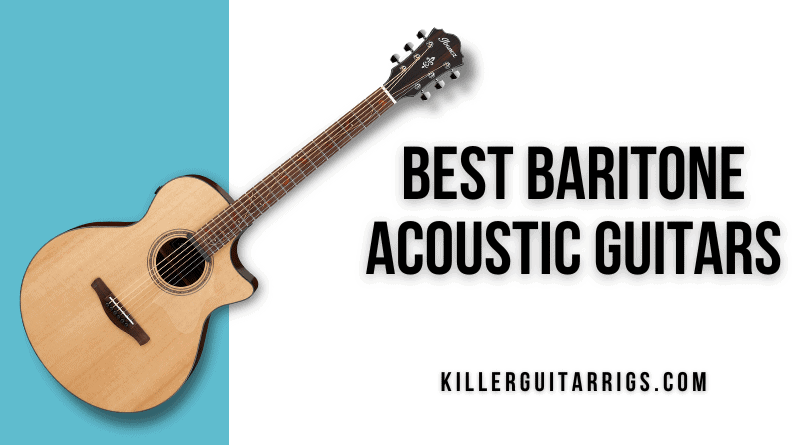Baritone guitars offer a unique sound and can be a breath of fresh air for performers and songwriters. These instruments allow players to explore an entirely new sonic spectrum while relying on common chord shapes, patterns, and scales.
Although the strings on a baritone guitar are tuned down a fourth (in most cases), the relationship between the strings remains the same as in a regular guitar.
Baritone guitars have been in use for years and can work wonders in different genres. For instance, in rock, John Petrucci has used them with great results, while in Jazz, legend Pat Metheny has done the same.
Since they produce a much lower and therefore bigger sound than regular acoustics, baritone guitars also need to have stronger bracing, bigger bodies, and longer scale lengths to accommodate the sonic shift. There are several models out there, and today we give you the five best. Keep reading to find out more.
Read more about our review process.
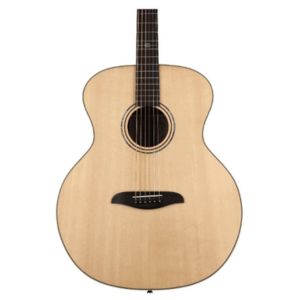
Alvarez Yairi YB70 Baritone Acoustic Guitar
Features: Solid Sitka spruce top, Solid East Indian rosewood back/sides, Direct coupled bridge
Benefits: Incredible sustain, Massive volume, Meticulously hand crafted
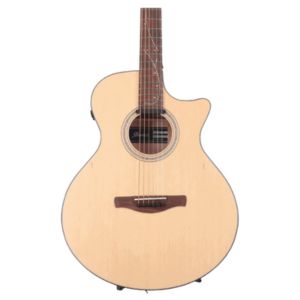
Ibanez AE275BT
Features: 27" Scale length, Custom Ibanez electronics, Solid Sitka spruce top
Benefits: Superb playability, Huge projection and volume, Gorgeous aesthetics
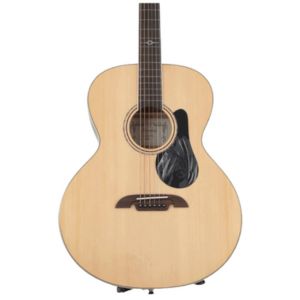
Alvarez ABT60 Artist 60 Baritone Acoustic Guitar
Features: A+ Sitka spruce top, V to C Neck profile, 27.5" Scale
Benefits: Strong dynamic response, Bold tones, Reliable tuning stability
Contents
Our Top 3
The Ibanez AE275BT is our Top Pick. This instrument comes with a unique combination of tonewoods for amazing projection and detailed tone that came through from our first strum. Additionally, you get Ibanez Custom Electronics for plugged-in performance.
The Alvarez ABT60 Artist 60 is our Budget Choice. It is especially good for those looking into their first baritone, or for songwriters searching for something new to draw inspiration from. This guitar offers fantastic sound and playability at a very affordable price.
Finally, the Alvarez Yairi YB70 is our Editor’s Choice and offers world-class craftsmanship for the discerning musician. This top-notch baritone acoustic is made with a AA Sitka spruce top and East Indian rosewood back and sides, producing a deep bass as well as gorgeous top-end sparkle, with great projection and volume.
Individual Reviews

Ibanez AE275BT
A unique combination of woods for a great baritone guitar.
Ibanez has been one of the most respected guitar brands for decades. They are renowned for offering musicians great instruments at a fair price, and this baritone guitar is no exception and comes with nice tone and playability.
The Ibanez AE275BT is a baritone acoustic-electric guitar that features a gorgeous solid Sitka spruce top, for amazing projection and detailed tone that came through from our first strum. The sides and back are made of Okoume, and add to the tonal character of this instrument. We got a sound similar to Mahogany back and sides, but with a brighter high end that was apparent, especially while strumming open chords loudly.
Besides the quality tonewoods featured on the AE275BT, Ibanez also chose to include a real bone nut and saddles for preserving vibrations better than basic plastic, a common choice for instruments at this price. This guitar gave us a nice definition and detail, from open chords, all the way to subtle fingerpicking parts.
We also loved the Ibanez Advantage bridge pins, which are far superior than plastic ones. Much like in a guitar nut, these bridge pins also help preserve your tone better, and add up to the nice projection and sustain that the AE275BT displays.
We then tried this guitar plugged into our Marshall AS50D acoustic amp, thanks to the Ibanez Custom Electronics. Although simple, this system gave us an accurate representation of the tone of this instrument. We also liked that the tone and volume knobs were included on the top part, as opposed to the inside of the soundhole, which can be cumbersome for adjustments during songs.
Regarding playability, we felt comfortable playing this baritone thanks to its Nyatoh Comfort Grip neck which features rounded fretboard edges for a smoother overall feel. We also liked the feel of the Katalox neck, which was responsive to our playing. Katalox is an incredibly dense wood that comes from Mexico and Central America and makes for great fretboards without costing a fortune.
With a typical baritone guitar 27″ scale length, nut width of 1.732″, and radius of 15.7″, the AE275BT gave us a comfortable playing experience at all times, even at the higher frets.
In short, if you’re looking for a baritone guitar that delivers in tone, playability and features, and also gives you the ability to plug in to a PA or amp, this Ibanez is a great choice.
Verdict: The Ibanez AE275BT is a fantastic baritone acoustic-electric guitar featuring a mix of common with unique tone woods for great tone and playability. With a Sitka spruce top, Okoume back and sides, and Katalox for the fretboard, this guitar is a fantastic choice for the working musician looking for a baritone.
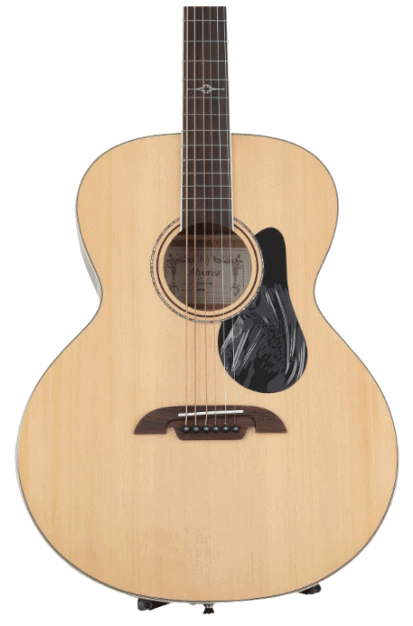
Alvarez ABT60 Artist 60
Good features, tone and playability at a very affordable price.
This guitar is a great choice for folks that want an affordable baritone, but still, wish for a good-sounding instrument that delivers in tone and playability. The ABT60 is especially good for those looking into their first baritone, or for songwriters that simply want to have another sonic tool to draw inspiration from.
The Alvarez ABT60 Artist 60 is a baritone guitar with sound, playability, and features that are better than those found with comparably-priced instruments. The first thing we liked about this guitar is the A+ Sitka spruce top. We strummed it a few times with a pick and got great resonance and powerful volume.
The back and sides on the ABT60 are made of mahogany, which is also a fantastic choice as it traditionally pairs well with the spruce top. We really liked how full the sound of this guitar is, great for strumming chords to add depth and lower end to songs.
We also liked the sound we got while fingerpicking some parts. With the E string tuned to B, our parts had a deep low end that was clear and never muddy. This was also true when we strummed chords, and we got nice string separation for a baritone guitar that is so affordable.
This baritone acoustic felt comfortable in our hands, and we particularly liked the feel of the hardwood mahogany neck. Its design features a hybrid soft “V” to “C” shape, which greatly aids playability throughout the fretboard. With a responsive fingerboard made from Indian laurel, this instrument has 21 frets and feels good in all positions.
Alvarez designed this baritone with a 27.75-inch scale length. This is a bit longer than most baritones, but the tradeoff is that you get a better tone than with a shorter scale length at this price range.
Although we liked how it sounded and felt while fingerpicking, the ABT60 is especially good for strumming chords. This is where its projection and volume really come through, with a depth and balance that suggests a higher price tag.
In short, a good and affordable guitar for those looking for their first baritone, and for songwriters looking to add more sonic depth to their writing sessions.
Verdict: The Alvarez ABT60 Artist 60 is a great baritone guitar for folks looking for a truly affordable instrument. However, it comes with features that are beyond a budget baritone guitar, including an A+ Sitka spruce top and mahogany back and sides.
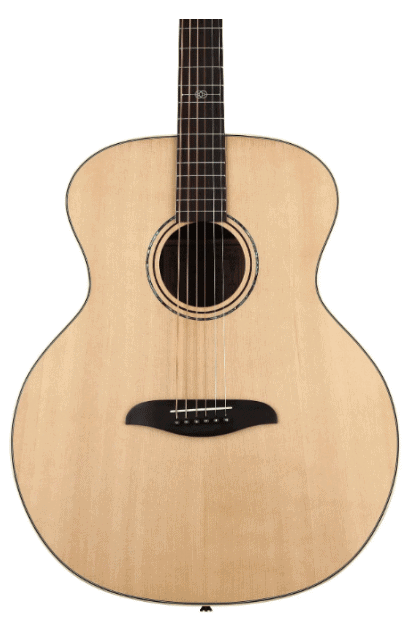
Alvarez Yairi YB70
World-class craftsmanship for the discerning musician.
Alvarez brought the best work of its renowned luthiers to this baritone guitar. It gives the user a beautiful tone with tons of bass and sparkly highs while remaining comfortable at all points of its responsive fretboard.
The Alvarez Yairi YB70 is a top-notch baritone acoustic made with a AA Sitka spruce top as well as East Indian rosewood back and sides. This tonewood combination gave us a deep bass as well as beautiful top-end sparkle, on a projecting sound with plenty of volume.
Our open chord passages had a nice low-end thump and overall great resonance. The same was true for some acoustic riff-inspired playing and soloing, where we got a sweet yet big sound from this baritone. From barred chords to fingerstyle, the Yairi YB70 had a full resonance with and beautiful tone for a variety of uses and situations.
This guitar will be a dream come true for songwriters, as it offers inspiring sounds. Besides, you get a unique tone given that this guitar is tuned a fourth down, producing a gorgeous extended range. Solo performers will also be able to fill a lot more frequency spectrum space with this Alvarez baritone.
Part of the great projection and tone on this baritone guitar is based on its 2-piece Direct Coupled bridge construction. The luthiers at Alvarez separated the bridge into two pieces while anchoring the strings at the top. The result is an increased bridge tension and downward pressure, for superior volume, sustain, and enhanced projection. Furthermore, this design avoids the common and highly nagging problem of the bridge lifting off the soundboard.
Sound and projection are not the only areas where the Yairi YB70 excels. Playability is also superior on this instrument. We played it for a while, without feeling the added effort that it sometimes takes to play a baritone guitar, from holding the bigger instrument to fingering chords on a longer-scaled instrument.
The first thing we liked was how sturdy its mahogany neck was. It featured a “V” to “C”-shape, which gave us plenty of comfort for chords on the first few frets, as well as more intricate passages and voicings as we went up the neck. We loved the responsive ebony fingerboard as well as the flat 15.75-inch radius on this guitar. The longer 27-23/32-inch scale length was no impediment for moving about the neck comfortably and gave this guitar a bit more of that low-end punch.
In short, a fantastic baritone guitar with superior Japanese craftsmanship. From tone to projection and playability, this instrument is a great choice for discerning professionals that value quality.
Verdict: The Alvarez Yairi YB70 is a stellar baritone acoustic made with a AA Sitka spruce top and East Indian rosewood back and sides. This guitar offers great playability, paired with amazing projection, tone, and volume.
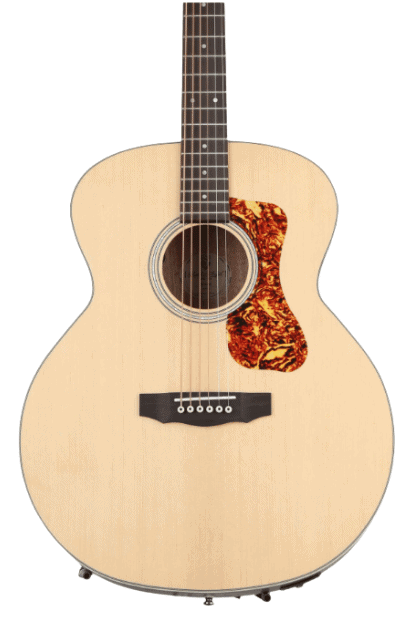
Guild BT-240E
Massive sound with value for money.
Guild has a substantial tradition and reputation among acoustic guitarists. This baritone acoustic is in line with what we expect from this company and offers you quality and playability for a great price.
The Guild BT-240E is a baritone acoustic guitar with an F-Jumbo body that gave us a massive sound from our first strum. We started by playing some open chords and loved the tone and projection of this instrument.
Besides the F-Jumbo size of this guitar, its mahogany back and sides as well as the choice of solid Sitka spruce for the top, greatly contribute to a full and robust tone. This tonewood selection also gave us a nice blend of low-end and midrange, as well as great volume.
Guild made the BT-240E with its renowned scalloped X-bracing. This pattern gave us nice resonance and sustain, and employs crisscrossing and overlapped braces in the body. Along with the tonewoods, and F jumbo size, this bracing pattern contributes to this instrument’s big sound.
The BT-240E is tuned a fourth below standard tuning. From the lower strings to top ones, the tuning is B-E-A-D-F#-B. For that to translate into amplified sound, the BT-240E features a Guild/Fishman Sonitone GT-1 electronic system. We plugged this guitar into our Roland JC-120 amp and got an authentic baritone acoustic tone.
This Guild/Fishman system comes with volume and tone control that are discreetly mounted directly on the soundhole for comfortable access. We wish it had at least a three-band EQ for greater control and the ability to dial our tone better, as a single-tone and single-volume control feels limited.
Although this baritone guitar may feel gigantic for some, we found that it gave us nice playability. The mahogany neck felt stable and nice to the touch, and the Pau Ferro fingerboard gave us a nice response on the 20 frets that this guitar features. It does use a longer scale length of 27″, but that is to be expected for baritone guitars, and was not an issue.
In order to enhance the BT-240E’s tone even further, Guild included a genuine bone and nut saddle. Additionally, we loved the choice of a Pau Ferro bridge that added to the instrument’s resonance and tone. In short, a nice baritone acoustic with great projection at an affordable price.
Verdict: The Guild BT-240E is a baritone acoustic-electric guitar that features an F-Jumbo body with mahogany back and sides and a solid Sitka spruce top. Along with X-Bracing construction, this guitar provides massive sound as well as nice playability.
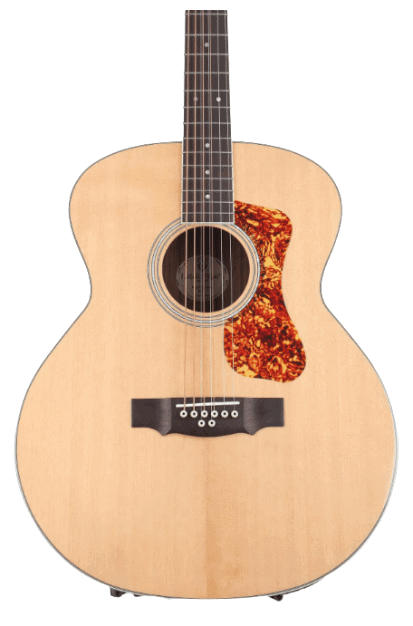
Guild BT-258E
Massive baritone sound on an 8-string guitar.
This guild ups the ante by providing eight strings. As a result, you get big baritone tone with more top end sparkle, as well as nice playability and the ability to plug into a PA or acoustic amp.
The Guild BT-258E is an F-Jumbo body acoustic that comes with two extra strings. It is tuned a fourth lower from standard tuning, at B, E, A, A, D, D, F#, and B. At first, it took us a little bit to get used to the two extra strings. It reminded us a bit of the feel of a 12-string guitar, but only for the third and fourth strings.
Naturally, with eight full strings, a Jumbo body, a rosewood back, and sides, as well as a solid Sitka spruce, this guitar gave us a massive sound. Each of our strums had plenty of low-end and a good dose of midrange with sparkling highs, especially as the third and fourth strings were doubled at an octave higher with the extra two strings.
We also got full projection and volume with the Guild BT-258E, and this guitar proved to be great for strumming chords. Although its two added strings add to the girth of the sound, they do get in the way of fingerpicking or playing lines. Naturally, baritone guitars are not primarily used for fingerpicking, but in case that is part of what you do, consider a different instrument.
Regarding playability, the GT-285E comes with a mahogany neck with a responsive pau ferro fingerboard that was comfortable. This baritone guitar also features scalloped X-bracing, another great feature that helps its big sound and projection.
foGuild/Fishman GT1 with Sonicore pickup. We tried it in tandem with our Roland JC-120 amp and got a natural tone that was balanced. The system itself comes with a volume knob and a single tone knob, both mounted directly in the soundhole.
In short, a guitar with tons of projection and big tone, made especially for strumming and adding tone and texture to your music.
Verdict: The Guild BT-258E provides massive sound and volume by employing an F-Jumbo body and two extra strings. The eight strings are tuned a fourth lower, and add a bit of sparkle to the overall big sound of this guitar. It also comes with a Guild/Fishman GT1 system for plugged in performance.
How To Choose The Right Baritone For You
Baritone Acoustics offers a unique tone and playing experience. That said, they are far less common to find in music stores, and options like color, finishes, and wood selection may seem a bit more limited.
Below we share a few things to be aware of before making your selection. Pay special attention to them, especially if this is your first baritone acoustic.
Heavier strings
Baritone guitars come with higher gauge strings. It may take you a while to get used to their much higher gauge, as they are a bit harder on the fingers and may seem nearly impossible to bend.
A common gauge of strings for acoustic baritones can range from .016 and .070. These instruments will likely take some time to get used to. Not only are they larger but sometimes harder to position yourself to play them. Because of the heavier strings, your playing experience will be altered. Naturally, practice conquers everything, but don’t be discouraged if you experience some discomfort at first.
Longer scale lengths
In order to retain enough tension to make them playable, baritone acoustic guitars feature extended scale necks. Scale length is the distance between the bridge and the nut of the guitar, and has a direct impact on the playability and comfort of the instrument.
In order to accommodate heavier strings and lower tunings, baritone guitars come with longer scale necks. These necks can be nearly two inches longer than the ones featured in a standard guitar. Along with heavier strings, longer scale lengths will alter your playing experience on the instrument.
Electronic System
An electronic system is mandatory if you want to perform live with your baritone acoustic. And because baritone acoustics sound much lower than regular acoustics, the electronics employed are crucial to achieving a defined low-frequency tone.
In other words, pay close attention to the preamp, pickups, and other elements that allow you to plug in your baritone acoustic. With these instruments, muddiness, boominess, and lack of clarity are a much bigger issue.
Just like with regular acoustics, you also have the option of swapping pickups to get something of better quality. However, this demands an extra cost and you will likely need a luthier or more experienced professional to carry out the installation successfully.
Tonewoods
Just like with regular acoustics, the choice of wood used in a baritone guitar has a significant effect on tone, projection, response, and playability. Personal preference also has a large impact on your tonewood choice, but below we share some common options and their traits.
Spruce
Spruce is a very popular option for guitar tops. Acoustic guitar players love this tonewood because it produces a smooth tone with nice overtones. Spruce is beloved not only for strumming but fingerpicking as well.
Cedar
Cedar is another typical alternative for guitar tops. It gives you warmth and a musical quality. This tonewood is preferred by players that strum at medium levels, as well as finger pickers.
Rosewood
Rosewood is arguably the most popular choice for backs, sides and fingerboards. This tonewood is known for being incredibly well-balanced and a popular choice for folks that lack a darker-sounding tone. It is also beloved for its rich bass, present mids, and nice highs.
Mahogany
Mahogany is a very common choice for necks and fingerboards and it’s also quite popular for tops, backs, and sides. This tonewood produces strong mids, straightforward high-end, and tight bass.
Walnut
Walnut is not as common as Mahogany, Rosewood, or maple but still preferred by some. It is mostly used for backs and sides and produces a well-balanced tone.
Maple
Maple may be the most common tonewood for necks. It is very hard and features excellent resonant qualities. This tonewood is the choice for many guitar necks, both electrics, and acoustics.
Ebony
Ebony is a remarkably hard wood that delivers a brilliant tone. It is also relatively popular for higher-end instruments as it makes for smooth fingerboards.
Final Thoughts
Baritone acoustics provide a unique sound and tone. Because they are tuned much lower than a regular guitar, players get a much deeper sound. Although most of them are tuned down a fourth, some go as far as a fifth, while others are tuned down a third. As a result, a baritone guitar can unlock a vast array of ideas, making it great for composers, songwriters, and solo players in general.
Additionally, baritone acoustics can significantly thicken a part, whether it be just a line or a strummed chord progression, which is partly why they are sought after to play in bands and ensembles. All of this is done while employing the same familiar chord shapes and voices, as well as scales and patterns from a regular acoustic guitar.
However, baritone acoustics also come with a set of challenges, particularly when it comes to playability. Their heavier strings, longer scale lengths, and bigger bodies can be challenging to master at first.
Plugging them into a PA or acoustic amp also presents another challenge, as amplifying a much lower instrument, while keeping the low end defined is far trickier than with regular acoustics. Like most things, try to get a quality electronic system for your baritone acoustic to ensure the best possible results when performing live.
The Ibanez AE275BT is our Top Pick. This baritone guitar features a remarkable combination of tonewoods for great projection and clear tone, as well as nice responsiveness and playability. Besides, it is outfitted with Ibanez Custom Electronics for plugged-in performance.
Next up, the Alvarez ABT60 Artist 60 is our Budget Choice. This guitar is particularly good for those looking into their first baritone, or for songwriters that want to write with a much lower and richer instrument. This guitar offers great sound and playability for the price.
Finally, the Alvarez Yairi YB70 is our Editor’s Choice, with world-class craftsmanship for the discerning professional. This outstanding baritone acoustic comes with a AA Sitka spruce top as well as East Indian rosewood back and sides. The result is a deep bass as well as beautiful top-end sparkle, with superb projection and volume.

